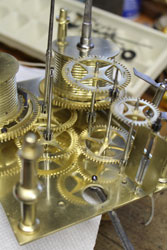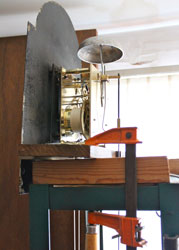If your clock has stopped, or is striking erratically or your barometer or music box is in need of repair, please contact us and we will discuss with you what the problem seems to be. If it is in need of help, we will pick it up and deliver it upon completion of the work, which usually takes one to three weeks depending on the work needed. We repair clocks, barometers and music boxes. All full repairs are guaranteed for 2 years, and of course all clocks purchased from us are guaranteed for 2 years as well.
Please see our blog post: “Oh no, I wound my clock to tight”
Repair and restoration of a clock movement starts with analysis of the movement in its present state. Initially, depending on the type and size of the clock, only a minor oiling may be needed. If more work is needed, we scrutinize the trains of power, whether time, strike or music train, and look for wear, friction points, loose parts, missing parts, or previous poor repair work, then it is taken apart. Each screw is carefully put aside so it will be placed back in its original hole. Steel is separated from brass and both are cleaned. Next, all the pieces are examined again for, ironically, the effects of time and motion.
the type and size of the clock, only a minor oiling may be needed. If more work is needed, we scrutinize the trains of power, whether time, strike or music train, and look for wear, friction points, loose parts, missing parts, or previous poor repair work, then it is taken apart. Each screw is carefully put aside so it will be placed back in its original hole. Steel is separated from brass and both are cleaned. Next, all the pieces are examined again for, ironically, the effects of time and motion.
After many years, it may need further work if the movement is showing a failure to keep time. The simple constant action 24 hours a day, 365 days a year, of the parts and their necessary touch points produce wear that interferes with the clock’s accuracy. The oil also loses its viscosity causing springs to literally stick together and come to a complete halt. At this point, everything is cleaned. For instance in a longcase clock, as the pallet controls the release of power, it wears. This wear needs to be removed, followed by re-hardening and polishing of the pallets. The pivot points wear with each turn of the arbors and may need to be turned on a lathe and polished.  Pivot holes may be oval from wear and need to be bushed. Other problems may be gears with broken teeth due to an exploding spring or an out-of-control weight. Each piece is now individually polished. Care must be taken to polish the brass only, while not removing the edges or in anyway damaging the engraving.
Pivot holes may be oval from wear and need to be bushed. Other problems may be gears with broken teeth due to an exploding spring or an out-of-control weight. Each piece is now individually polished. Care must be taken to polish the brass only, while not removing the edges or in anyway damaging the engraving.
Following completion of repairs, it is time to put the clock back together one piece at a time. The steel screws have been burnished and or blued and put back in their original locations. As each gear is put in place, the system of gears and pinions, either the power train or the striking train, is put into motion to see that everything is moving freely. When all is clear, small drops of clock oil are put in the pivot points and the movement is put under power. Finally, for instance for a longcase, the movement is set up on a clock stand in the workroom, the weights are hung and or the spring is wound, it is set to time and watched for time keeping and striking if necessary.  If there is any failure, the clock must be analyzed, taken apart again and the problem corrected. After this, the movement is put back on the clock stand and watched again. If there are no problems, it is put back in the case, set to time again and observed. When all is well, the clock is ready for pick-up or delivery.
If there is any failure, the clock must be analyzed, taken apart again and the problem corrected. After this, the movement is put back on the clock stand and watched again. If there are no problems, it is put back in the case, set to time again and observed. When all is well, the clock is ready for pick-up or delivery.
Repair brings an item back to working order. Restoration involves bringing an item to it’s full glory. This involves the clockmaker as well as cabinet makers, painters, guilders and glaziers. All of our craftsmen have years of experience and training and meet Mr. Grunsell’s standard of excellence. Conservation attempts to halt the effects time (ironically), to prevent further decay of the item. For instance, loose moldings or, peeling or chipped paint may be repaired.
All our clocks are guaranteed for 2 years from purchase date.
